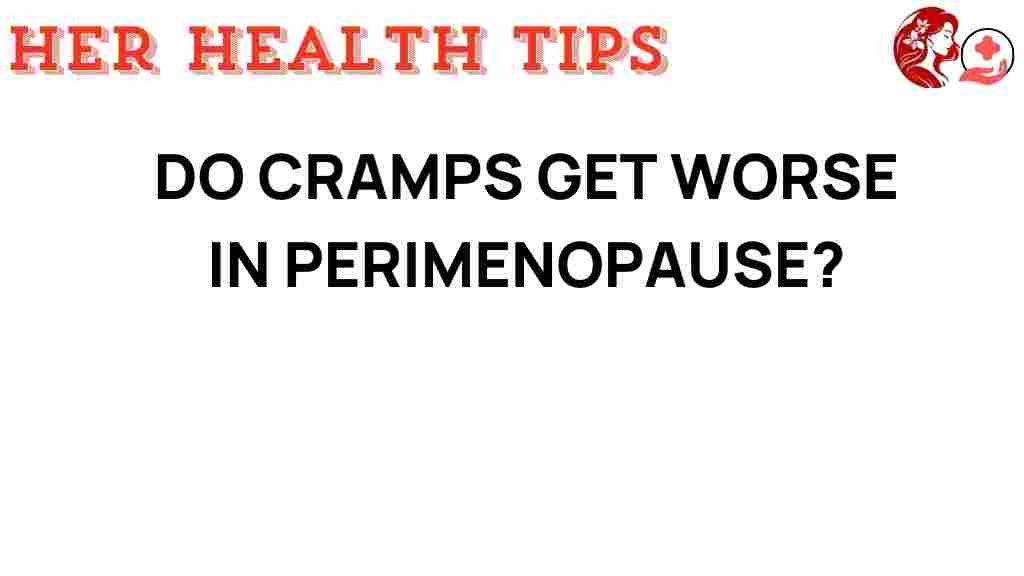Unraveling the Mystery: Do Cramps Intensify During Perimenopause?
Perimenopause is a transitional phase that every woman experiences as she approaches menopause. This period is marked by significant hormonal changes, particularly in estrogen and progesterone levels, which can lead to various symptoms, including changes in the menstrual cycle and the intensity of cramps. Understanding how these cramps can change during perimenopause is crucial for effective pain management and overall women’s health.
Understanding Perimenopause and Its Impact on Cramps
Perimenopause typically begins in a woman’s 40s, although it can start earlier or later. It lasts until menopause, which is defined as the point when a woman has not had a menstrual period for 12 consecutive months. During this time, the body undergoes various hormonal fluctuations that can impact reproductive health significantly.
One common symptom experienced during this phase is cramps. As the menstrual cycle becomes irregular due to hormonal changes, many women report experiencing cramps that are either more intense or different in nature than they were before. This can lead to concerns about pain management and overall reproductive health.
Hormonal Changes During Perimenopause
The key to understanding cramps during perimenopause lies in the hormonal changes that occur. Here’s a closer look at the hormones involved:
- Estrogen: Levels of estrogen can fluctuate significantly during perimenopause. This hormone is primarily responsible for regulating the menstrual cycle and plays a crucial role in the body’s reproductive health.
- Progesterone: This hormone is produced after ovulation and is essential for preparing the uterus for potential pregnancy. Its levels also fluctuate during perimenopause, which can affect the menstrual cycle and the severity of cramps.
These hormonal changes can lead to a variety of menstrual symptoms, including:
- Irregular periods
- Heavy bleeding
- Increased intensity of cramps
- Mood swings
Why Do Cramps Intensify During Perimenopause?
As women transition into perimenopause, they may notice an increase in the intensity of cramps due to several factors:
- Irregular Ovulation: With fluctuating hormone levels, ovulation may become irregular. This can lead to more intense uterine contractions and, consequently, stronger cramps.
- Endometrial Changes: The endometrium (the uterine lining) may thicken more than usual in response to hormonal fluctuations. When menstruation occurs, the body expels this excess lining, which can lead to more severe cramps.
- Increased Prostaglandins: Higher levels of prostaglandins, which are chemicals that promote uterine contractions, can lead to increased pain during menstruation.
Step-by-Step Process: Managing Cramps During Perimenopause
Managing cramps during perimenopause involves a multi-faceted approach. Here’s a step-by-step guide to help alleviate discomfort:
1. Track Your Symptoms
Keeping a menstrual diary can help you identify patterns in your symptoms. Note the intensity of cramps, the duration of your periods, and any other related symptoms. This information can be valuable for discussions with your healthcare provider.
2. Consult Your Healthcare Provider
Discuss your symptoms with a healthcare professional. They can offer personalized advice and determine if further investigation is necessary. They may suggest:
- Hormonal therapy options
- Non-hormonal medication for pain relief
3. Lifestyle Adjustments
Making certain lifestyle changes can significantly impact your cramps:
- Diet: Incorporate anti-inflammatory foods, such as fruits, vegetables, and whole grains, while reducing processed foods and sugars.
- Exercise: Regular physical activity can help reduce the severity of cramps and improve overall health.
- Stress Management: Techniques such as yoga, meditation, or deep breathing can help manage stress, which may exacerbate cramps.
4. Pain Management Strategies
There are several options for managing cramps effectively:
- Over-the-Counter Pain Relievers: NSAIDs such as ibuprofen can help alleviate cramps.
- Heat Therapy: Applying a heating pad to the abdomen can provide relief from cramps.
- Supplements: Some women find relief through supplements such as magnesium, omega-3 fatty acids, or vitamin E.
Troubleshooting Tips for Intense Cramps
If you experience intense cramps during perimenopause, consider these troubleshooting tips:
- Monitor Changes: Keep a close eye on changes in your cycle or the intensity of your cramps. If you notice significant changes, consult your healthcare provider.
- Evaluate Medications: Some medications may exacerbate cramps. Review any medications with your healthcare provider.
- Consider Natural Remedies: Herbal options, such as ginger or chamomile, may offer relief. Always discuss these with your health provider first.
Conclusion: Navigating Cramps During Perimenopause
Understanding the relationship between perimenopause and cramps is crucial for effective pain management and maintaining overall women’s health. With the right knowledge and tools, women can navigate this transitional phase with greater ease. Remember, it’s essential to consult with healthcare professionals to tailor a management plan suited to your specific needs.
As hormonal changes affect the menstrual cycle and can lead to intensified cramps, being proactive about your reproductive health is key. Whether through tracking symptoms, lifestyle adjustments, or exploring pain management options, women can take charge of their perimenopausal experience.
For more information on women’s health during perimenopause, you can visit this resource. Additionally, if you’re looking for natural pain relief options, consider checking out this external link for more tips.
This article is in the category Reproductive and created by HerHealthTips Team
